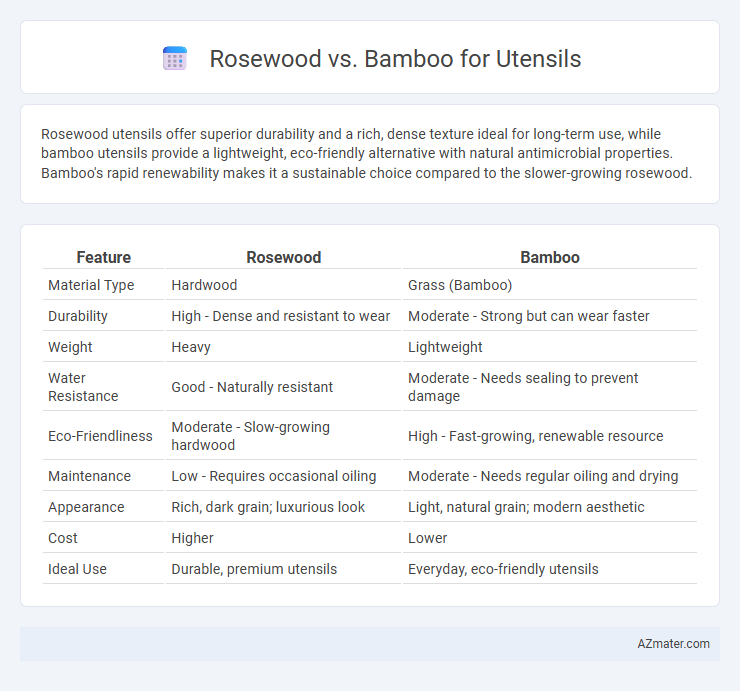Rosewood utensils offer superior durability and a rich, dense texture ideal for long-term use, while bamboo utensils provide a lightweight, eco-friendly alternative with natural antimicrobial properties. Bamboo's rapid renewability makes it a sustainable choice compared to the slower-growing rosewood.
Table of Comparison
| Feature | Rosewood | Bamboo |
|---|---|---|
| Material Type | Hardwood | Grass (Bamboo) |
| Durability | High - Dense and resistant to wear | Moderate - Strong but can wear faster |
| Weight | Heavy | Lightweight |
| Water Resistance | Good - Naturally resistant | Moderate - Needs sealing to prevent damage |
| Eco-Friendliness | Moderate - Slow-growing hardwood | High - Fast-growing, renewable resource |
| Maintenance | Low - Requires occasional oiling | Moderate - Needs regular oiling and drying |
| Appearance | Rich, dark grain; luxurious look | Light, natural grain; modern aesthetic |
| Cost | Higher | Lower |
| Ideal Use | Durable, premium utensils | Everyday, eco-friendly utensils |
Introduction to Rosewood and Bamboo Utensils
Rosewood utensils are crafted from dense, durable hardwood known for its rich color and natural resistance to moisture and bacteria, making it ideal for kitchen use. Bamboo utensils, derived from fast-growing, sustainable grass, offer lightweight flexibility and natural antibacterial properties, promoting eco-friendly and hygienic cooking tools. Both materials provide distinctive benefits in terms of durability and environmental impact, suited for various culinary needs.
Material Properties: Rosewood vs. Bamboo
Rosewood exhibits high density, natural oils that resist moisture, and exceptional durability, making it resistant to cracking and warping in utensils. Bamboo offers lightweight strength, rapid renewability, and natural antibacterial properties, ensuring sustainability and hygiene in kitchen tools. Comparing material properties, rosewood provides sturdiness and a luxurious finish, while bamboo delivers eco-friendliness and enhanced moisture resistance.
Durability and Longevity
Rosewood utensils are renowned for their exceptional durability due to the wood's dense grain and natural resistance to wear and moisture, making them highly long-lasting. Bamboo utensils offer good longevity as well, with natural antimicrobial properties and a lightweight yet sturdy structure, though they may be more prone to cracking or splitting over extended use. Choosing rosewood provides superior durability for frequent kitchen tasks, while bamboo remains an eco-friendly option with reasonable lifespan under proper care.
Eco-Friendliness and Sustainability
Rosewood utensils, while durable and aesthetically pleasing, often come from slow-growing trees and can contribute to deforestation if not sourced responsibly, raising concerns about their long-term sustainability. Bamboo utensils are highly eco-friendly due to bamboo's rapid growth rate and renewable qualities, making them a sustainable choice that requires minimal resources and regenerates quickly after harvesting. Choosing bamboo over rosewood supports sustainable forestry practices and reduces environmental impact, aligning with eco-conscious consumer preferences.
Maintenance and Care Differences
Rosewood utensils require regular oiling with mineral or food-safe oil to maintain their rich color and prevent cracking, while bamboo utensils need less frequent treatment due to their natural water resistance. Bamboo is more resistant to moisture and microbial growth, making it easier to clean and less prone to warping compared to rosewood. Proper hand washing and immediate drying are essential for both materials to extend their lifespan and preserve their structural integrity.
Aesthetic Appeal and Design
Rosewood utensils are prized for their rich, dark grain and glossy finish, offering a luxurious and elegant aesthetic that enhances kitchen decor. Bamboo utensils showcase a lighter, natural color with smooth, uniform texture, providing a minimalist and eco-friendly appeal. Both materials cater to different design preferences, with rosewood emphasizing sophistication and bamboo highlighting sustainability and simplicity.
Performance in Cooking Applications
Rosewood utensils offer superior durability and heat resistance, making them ideal for high-temperature cooking tasks without warping or splintering. Bamboo utensils are lightweight and environmentally sustainable, providing excellent resistance to bacterial growth but may wear faster under heavy use. Performance-wise, rosewood excels in longevity and sturdiness, whereas bamboo delivers eco-friendly practicality with moderate durability in everyday cooking.
Price Comparison: Rosewood vs. Bamboo
Rosewood utensils are generally priced higher due to the wood's durability, rich color, and density compared to bamboo. Bamboo utensils offer a more budget-friendly option, benefiting from rapid growth and abundant availability which drives down production costs. While rosewood provides a premium, long-lasting choice, bamboo appeals to cost-conscious consumers seeking sustainability without sacrificing function.
Health and Safety Considerations
Rosewood utensils are naturally dense and resistant to bacteria, making them a hygienic option for food handling, though they may require more maintenance to prevent cracking and harboring microbes. Bamboo utensils, being naturally antimicrobial and fast-growing, offer a safer and eco-friendly alternative with low risk of chemical contamination, but can splinter over time if not properly maintained. Both materials are non-toxic, but regular cleaning and care are essential to ensure their long-term safety in kitchen use.
Which Is Better: Rosewood or Bamboo Utensils?
Rosewood utensils offer superior durability and a rich, elegant finish, making them ideal for long-term use and aesthetic appeal. Bamboo utensils provide a lightweight, eco-friendly alternative with natural antibacterial properties, ideal for sustainable kitchens. Choosing between rosewood and bamboo utensils depends on personal preference for durability versus sustainability and appearance.

Infographic: Rosewood vs Bamboo for Utensil
 azmater.com
azmater.com